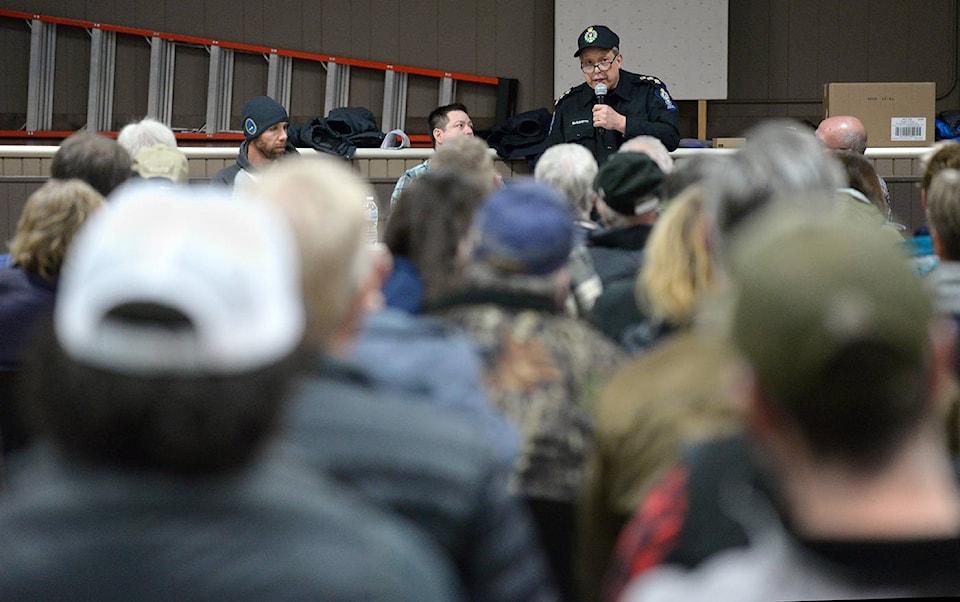Can humans and grizzly bears coexist? This question is on the minds of many in the Elk Valley and South Country but particularly those in Jaffray.
In previous years there have been about one to two calls per year from Jaffray locals regarding bear interactions. However in 2018 alone the RAPP (Report All Poachers and Polluters) line received 38 calls about bears spotted in the Jaffray area. Of these calls, the BC Conservation Service responded to 16, destroying one and hazing (scaring) another.
Jaffray calls accounted for more than half of those received for the entire Elk Valley. The rest, from Fernie, Sparwood and Elkford. Aside from Creston, which is typically a busy area for bears every year, Jaffray was the second busiest for bears in either the West or East Kootenay.
Although the number of callouts significantly increased last year, the number of bears destroyed by Conservation Officers (CO’s) has remained the same as previous years. The last instance of a bear being destroyed since 2014 was in 2015, when two were destroyed by Conservation Officers.
So what’s causing this increase in interactions between humans and bears? Approximately 200 people met at the Jaffray Community Centre on January 8 to discuss why this is happening and what they can do to mitigate the issue, with local government, provincial government, conservation officers and biologists in attendance.
Many possible causes and solutions were raised over the course of the meeting.
In December 2017 the provincial government announced it would end the hunt of grizzly bears in B.C., with the exception of hunting by First Nations peoples. The spring of 2018 served as the first season in B.C. that grizzly bears were not hunted, and some Jaffray locals attributed this to the increase in local bear activity.
Kootenay East MLA Tom Shypitka agreed with this argument but Fish and Wildlife section head for the Kootenay-Boundary region, Holger Bohm, disagreed, saying it’s too early to see the effects of this ban.
Read more: OPINION: Jaffray bear meeting good first step, but not enough
“We are expecting the ban to have an effect eventually down the line… but I don’t think it (the increase) is any result of the ban quite yet. Bears don’t reproduce like bunnies, it takes quite a while for them to multiply,” Bohm said.
It was also suggested that the way Mainroad deals with roadkill is causing an increase in human-wildlife conflict. A ranch owner expressed her extreme displeasure at how close to her property dead animals are being disposed of.
“You’ve brought up attractants and you keep talking about fruit trees,” said the ranch owner. “One of the big attractants in my area is Mainroad dumping carcasses just off the road which happens to be affecting my ranch, as well as other ranchers on Tie Lake Road.
“I believe it’s not my fruit trees which brought the grizzlies into my yard this year, it was because they have a buffet given to them not far from my property.”
All panel members agreed that with an increase in attractants comes an increase in bear presence. Shypitka vowed to work hard to change the practices of boneyards, how they are used and where they are located.
Bohm explained that there was a Ministry worker whose primary focus was the management of the boneyards and how to improve them. Before he left the Ministry there was talk of fencing the boneyards, and Bohm said they hope to bring in someone to fill this position in the coming weeks.
Shypitka suggested that with minimal funding for wildlife mitigation and monitoring in the area and issues with communication with the Province, it’s hard for local biologists and the Conservation Service to formulate any solutions to this issue. Shypitka stressed that this wasn’t a Liberal vs. NDP issue.
“There is a disconnect between the Ministry, Victoria, and us,” said Shypitka.
“Being non-partisan here, we need money to bring this data forward. The funding that we’ve had for wildlife management in this province has been flatlining for probably 45 years. This is not a new issue. We need more funding and we need more voices to come to Victoria and say enough is enough. We need more resources, we need more data,” he said.
The increased use of forest service roads, as well as the impact of forest fires, were also suggested as probable reasons for the increase in bear activity in residential areas.
This comes after a new report found road density is the biggest threat facing key species habitat in the Elk Valley. One local feared the human-wildlife conflicts were only going to get worse.
“How do you expect to leave the top predator unchecked, and yet the human population is growing… and not expect there to be more conflict? It’s insanity,” she said.
“We went from one call to 38… and you guys took care of one. So next year how many is there going to be? What about five years from now? How many is there going to be then?”
Inspector Joe Caravetta with the BC Conservation Service insisted that simply relocating the bears is not the solution, because they’re just going to keep coming back.
“The safety of the public is our priority and I ask you to continue to call the RAPP line, we’ll monitor it,” said Caravetta.
“Everyone one of those calls gets checked by an officer, and if the bears become aggressive and a danger to public safety, we’ll deal with it.”
Shypitka hopes this is the first meeting of many pertaining to the grizzly bear issue, and suggested another will happen in April or May.
